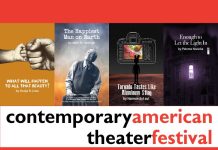The Playwright’s Playground – The Playmakers CATF 2015: Playwright Barbara Hammond on We Are Pussy Riot
This Special Edition of The Playwright’s Playground begins ‘The Playmaker Series: CATF 2015.’ In a series of in depth conversations, I speak with the artistic teams associated with the plays at this year’s Contemporary American Theater Festival. Playwrights, and the Directors share revealing behind the scene insights about their inspirations and the development of their new plays.
Barbara Hammond

Barbara Hammond is a New Dramatists resident playwright (Class of 2018) and is currently under commission from both the Royal Court Theatre and the Contemporary American Theatre Festival. Hammond is also a screenwriter and a director and is a member of New Dramatists and an Edward F. Albee Foundation Fellow.
She is a member of ASCAP and the Dramatists Guild, and was named one of the Influential Women of 2011 by the Irish Voice.
______________________
Sydney-Chanele: When in your childhood or later did you know that you wanted a life in the theater and the arts?
Barbara: I remember thinking when I was four that if I wanted to be a writer, I’d better hurry up and learn to read. I can’t remember ever wanting to be anything else.
When did you write We Are Pussy Riot and how many drafts went into what we’ll see on stage?
I write in layers — I don’t call each layer a new draft, because that suggests each draft is a new attempt at a finished product when it’s really just another coat of paint. The play CATF audiences will see is not the play I came down here with in June — that play is more of a punk prayer – rough, staccato and out-of-order. This play we are doing focuses more on Pussy Riot’s trial and the media attention they sought, and got, from the West. I now have two plays written on the same subject. This happens sometimes in the collaborative process.
Do you have a particular writing process? How was your process different in writing this commissioned play?
The biggest difference in this process was that I didn’t put words in the mouths of characters like Putin, Madonna, and Pussy Riot — I arranged them, but I invented very little of their dialogue. I used what is available from news sources, transcripts and my own interviews. Putin has said some stunning things, like “Maybe weakness is not the worst quality in a woman.” Also, I traveled to Moscow, interviewed Pussy Riot members that are still underground, and spoke to artists, soldiers, priests and teachers about life, death and current events.
Go through the process of how this Pussy Riot idea became a play. What surprised you in your research?
I decided to write this play after reading Katya, Masha, and Nadya’s closing statements before they were sentenced by the Russian court to two years in a labor camp for “hooliganism motivated by religious hatred.” I began to read everything I could about them, about Putin’s controversial re-election in 2012, and the increasingly important role of the Orthodox Church in post-Soviet Russia.
Then Ed Herendeen from CATF offered me the play commission in March 2014, the week the Cossack whipped Pussy Riot at the Sochi Olympics.
I had three workshop days at New Dramatists in New York, two last October with director Tea Alagic, and another day on my own in February with a different group of actors, including T. Ryder Smith, who is here in the CATF production.
What surprises me most is how people light up when they hear what I’m writing about, and at the same time have only a vague idea, and only a vague interest, in who Pussy Riot really are. Like any good brand, the details not only don’t matter but can be bothersome — which is problematic for a group that began with a political and artistic agenda.
I know that a playwright never writes anything without intention. What was your intention in titling the play We Are Pussy Riot instead of This is Pussy Riot?
I think a play like this is an invitation, the way that Pussy Riot’s performance art was an invitation, to people to wake up and think for themselves. You don’t have to agree with their methods to consider that we often go through life unquestioning of our institutions, laws and customs. Look what happened in the Supreme Court this week — gay marriage is now legal. Would a same-sex marriage that took place last year, or even last month, be “wrong” because it was illegal?
In South Carolina, Brittany Newsome did a very courageous thing by climbing the flagpole and taking down the Confederate Flag, but it was against the law. Maybe we are Pussy Riot every time we stand up to injustice. Margaret Mead said “Never doubt that a small group of thoughtful, committed citizens can change the world; indeed, it’s the only thing that ever has.” There are plenty of opportunities to do that, in every country on earth.
What do you hope that audiences take away with We Are Pussy Riot that they may know or even realize?
What would I die for? What would I go to jail for? Those are the questions I want people to ask themselves walking out of the play.
If the role of the artist is to tell the truth, what does We Are Pussy Riot reveal?
I think that is going to be a question the audience will have to answer, and I’ll be very curious to hear what they will say.
We Are Pussy Riot plays through August 2, 2015, at the Contemporary American Theater Festival performing in the Marinoff Theater – Center for Contemporary Arts/II – 62 West Campus Drive, in Shepherdstown, WV. For tickets, call the box office at (304) 876-3473/(800) 999-2283, or purchase them online.
We Are Pussy Riot contains graphic language. For mature audiences only.
LINK
Barbara Hammond’s website.

The Playwright’s Playground is a monthly in-depth conversation with local female playwrights and artists in the D.C. theatre community. Female theatre artists make up more than 50 percent of those involved in the theatre, yet the number of female playwrights being produced is dramatically lower. In this continuing Column, I will also interview and introduce DCMTA readers to the many talented playwrights in the DMV area to learn about their writing process, their inspirations, and their motivations.





